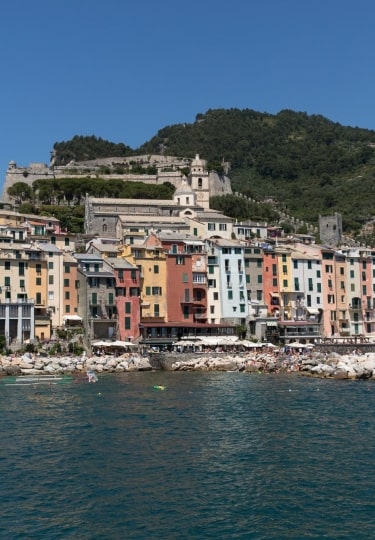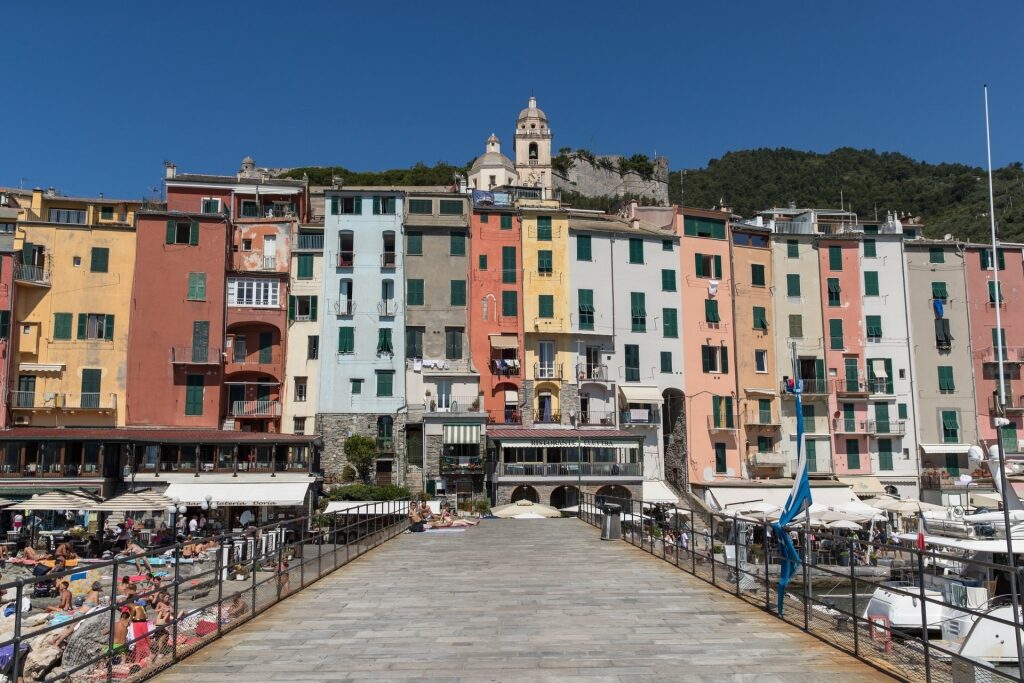The Ligurian coast—also known as the Italian Riviera—offers an abundance of postcard-perfect, pastel-patterned destinations to explore. For centuries, tourists have flocked to Italian Riviera cities like San Remo and Genoa for their singular charms and as a base from which to visit the exquisite towns and villages ornamenting the coast.
This sunny arc of Italian seaside bliss is an immense act of façadism, with the mountainous hinterland of the Riviera trimmed by a rainbow of delicate pastels where it meets the sea. In the era of pirates, the majority of medieval Ligurians lived in the wooded hills but today, the demographics are very much reversed.
Modern Ligurians, capitalizing on a reliable 300 days of sunshine per year and living in a place shielded from colder winds by the Alps and the Apennines, are often found enjoying the many beaches that grace this coastal region.
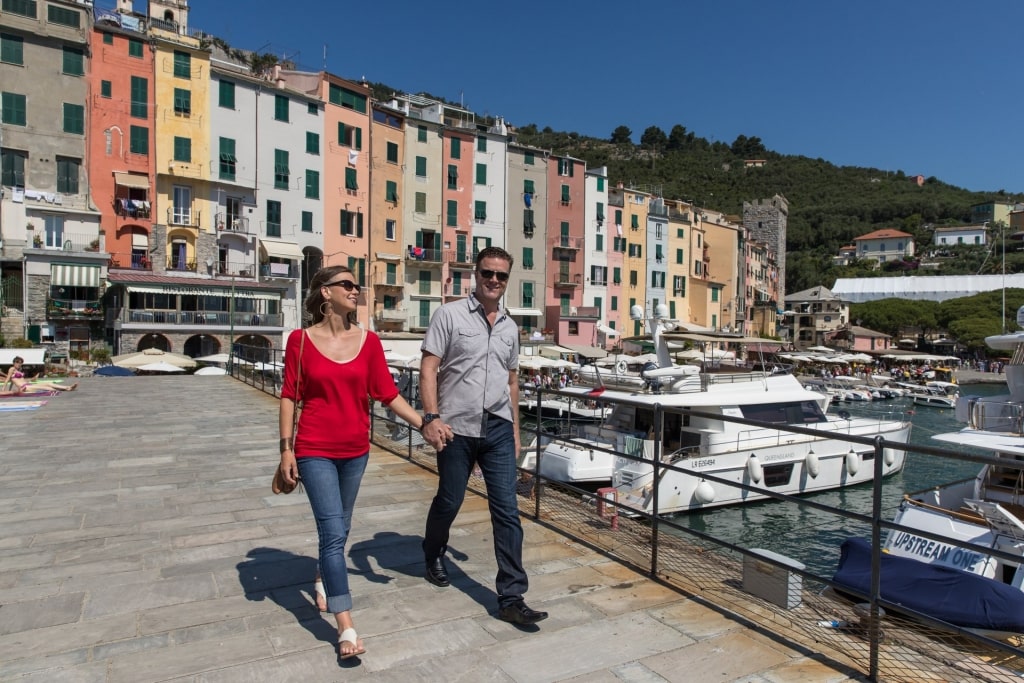
Portovenere
A sense of sun-bleached languor reigns amid the Italian Riviera towns such as Alassio and Portovenere, a calmer pace that distinguishes it from the glitzy French equivalent across the border. Part of it is that these Italian Riviera cities and towns still stubbornly retain a sense of their former fishing village identities—all the more extraordinary when you consider their evergreen popularity.
Here’s a list of classic Italian Riviera cities, and the towns dotted around them, that you should make time for.
Porto Venere
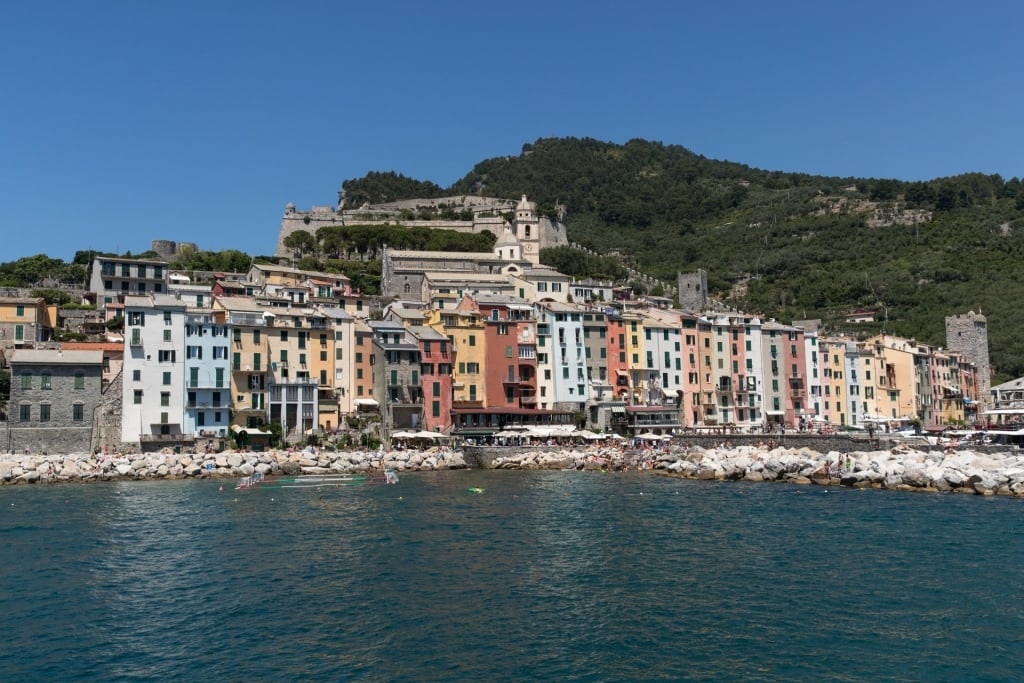
Porto Venere
Dubbed the “sixth Cinque Terre,” Porto Venere sits at the southernmost point of the fabled strip of Ligurian coast brightened by these five photogenic fishing villages. Its tall, colorful houses remain as inviting as a gelateria window display. The town’s authenticity remains tangible, despite it being part of one of Italy’s most visited strips of coast since the 18th century, the era of the Grand Tour, and beyond.
The gozzo ligures (traditional local fishing boats) bobbing on the turquoise water reflect the houses’ bold color choices back at the UNESCO World Heritage quayside. Meanwhile, the storm gray of the Gothic-style Church of San Pietro, perched on a promontory overlooking the sea, strikes a thrilling contrast.
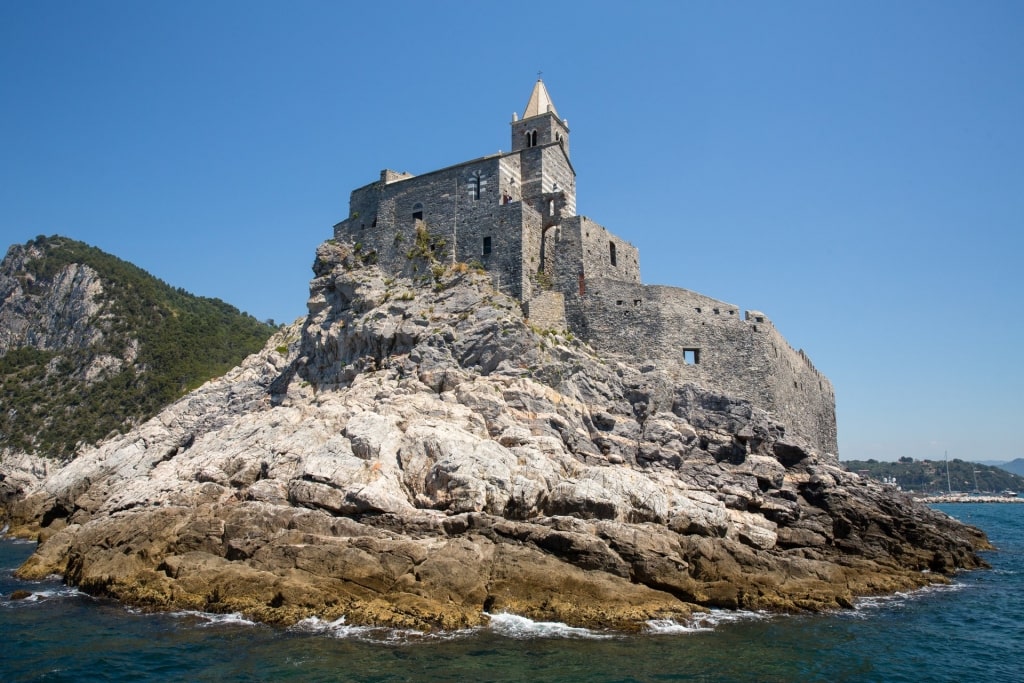
Doria Castle, Porto Venere
Porto Venere stirred the poetic spirit of Lord Byron, who famously lived and wrote here for a time. A sea cave and a café are named in his honor, and steps lead down from this atmospheric spot into the twinkling Ligurian Sea.
Whether you follow in his front crawl and try to cross the Gulf of La Spezia, or decide to visit the imposing Doria Castle above the village for a view across the gulf instead, is up to you.
La Spezia
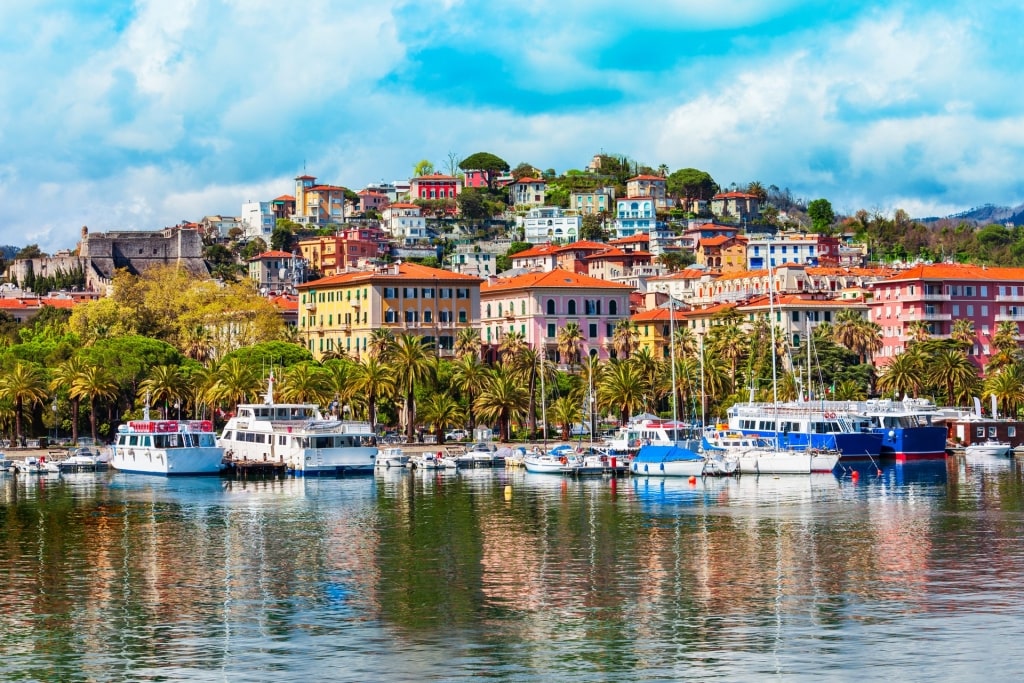
La Spezia
Tucked around the headland from Porto Venere is La Spezia, often used as a jumping-off point for visits to the five villages of the Cinque Terre, or Pisa. Like a kind of small-scale San Diego, La Spezia and its deepwater harbor have a special relationship with the navy. However, like the other Italian Riviera cities, La Spezia is a pony with more than one trick.
Of course, with its impressive military heritage, La Spezia is home to an engaging Technical Naval Museum. Chock-full of high seas history and Italian Special Forces equipment, there’s also a fantastic collection of ship figureheads. Somehow, the Italians make even a military museum a venue for remarkable artwork.
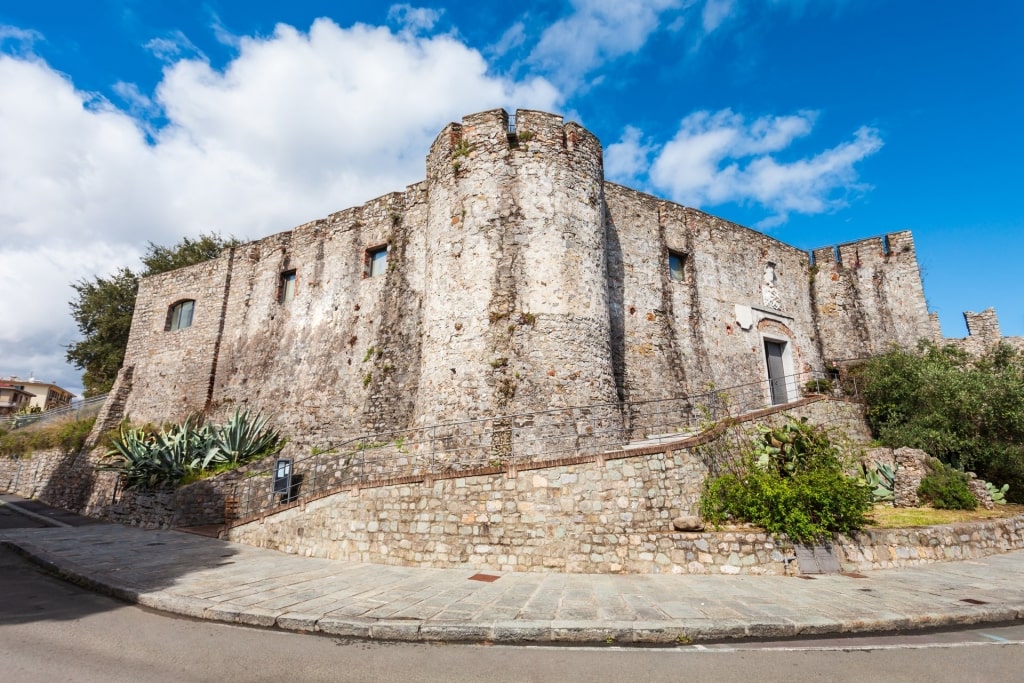
San Giorgio Castle, La Spezia
The 14th-century San Giorgio Castle stands as evidence of La Spezia’s longstanding strategic significance. This grim fortification, situated on a hill above the city and offering rewarding views across the coast, doubles as an Archaeological Museum with a focus on Roman and pre-Roman activity in the area.
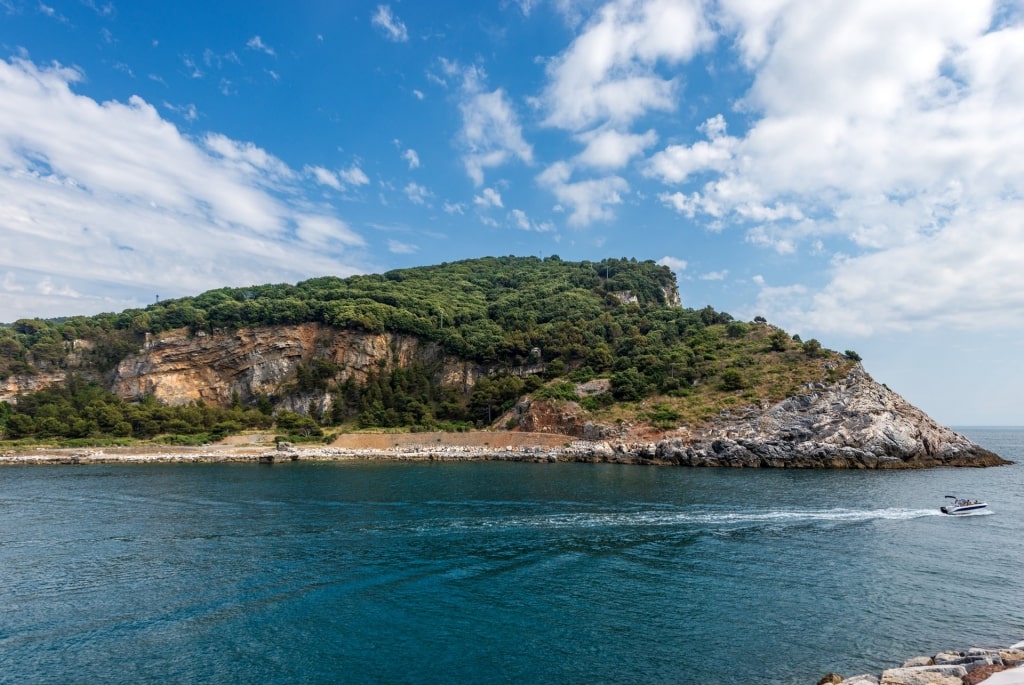
Palmaria
The Gulf of Spezia, for all of its military significance, has a second identity as “La Baia Dei Poeti”, or the Bay of Poets. In the 19th century, an influx of sensitive men of letters arrived to discover their poetic souls stirred by the evocative landscape and painterly habitations.
From La Spezia, it’s possible to join a boat tour of the UNESCO-protected islands of Palmaria, Tino, and Tinetto just offshore, with a guide explaining which poet was inspired to write what poem.
Alternatively, stroll the palm-shaded waterfront, picking up a snack of salty, rosemary-scented focaccia, a Ligurian specialty. Amid the lush Public Gardens, you’ll find a verdigris statue of national hero Garibaldi charging out from between the ferns. And keep your eye out for narrow masts of the tall ship Amerigo Vespucci, still employed by the Italian navy for training.
Alassio
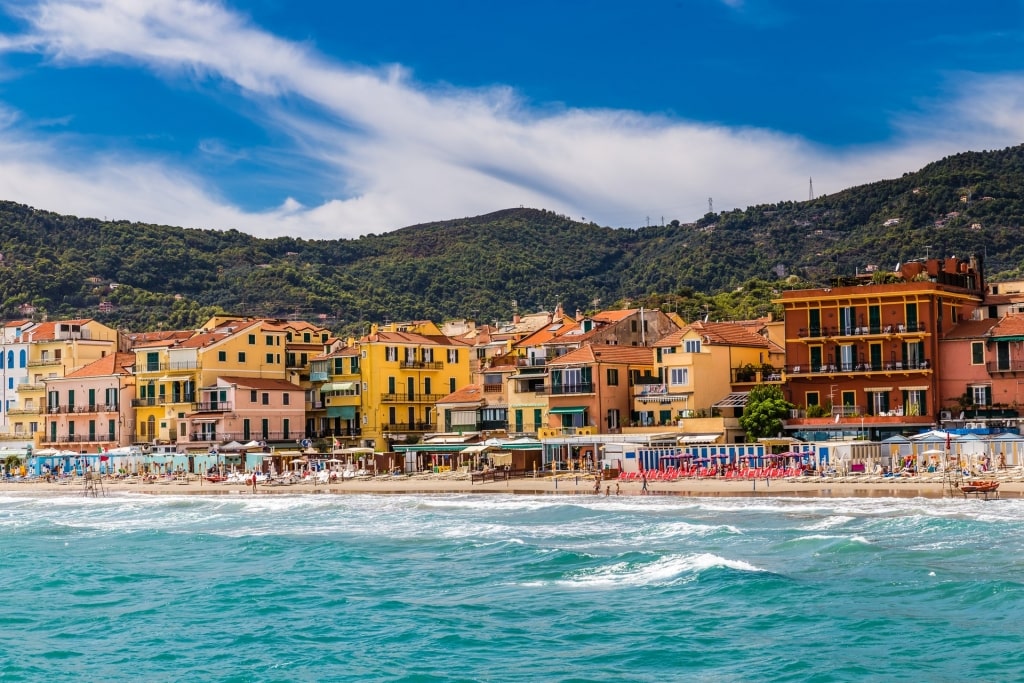
Alassio
Alassio, of all the Italian Riviera towns, is well known for attracting locals from nearby villages for its lively vibe at aperitivo hour.
Assisting Alassio’s laid-back air is the fact that, unlike many Italian Riviera cities and towns, there’s no road dividing the beach from the hotels and restaurants. The cherry on top is that Alassio’s is one of few significant stretches of sandy beach you’ll find on the Riviera. A further bonus is that the water here is shallow.
Il Budello (“the Intestine”) is Alassio’s main strip—a passageway of intimate bars, summery restaurants, and fashion boutiques. Between the glass-fronted shop windows, flashes of limpid ocean appear at the end of sandy alleyways.
Pop into the historic Balzola pasticceria for a taste of the belle époque, and make sure to try the local specialty Baci di Alassio (Alassio Kiss), a chocolate ganache-filled macaroon.
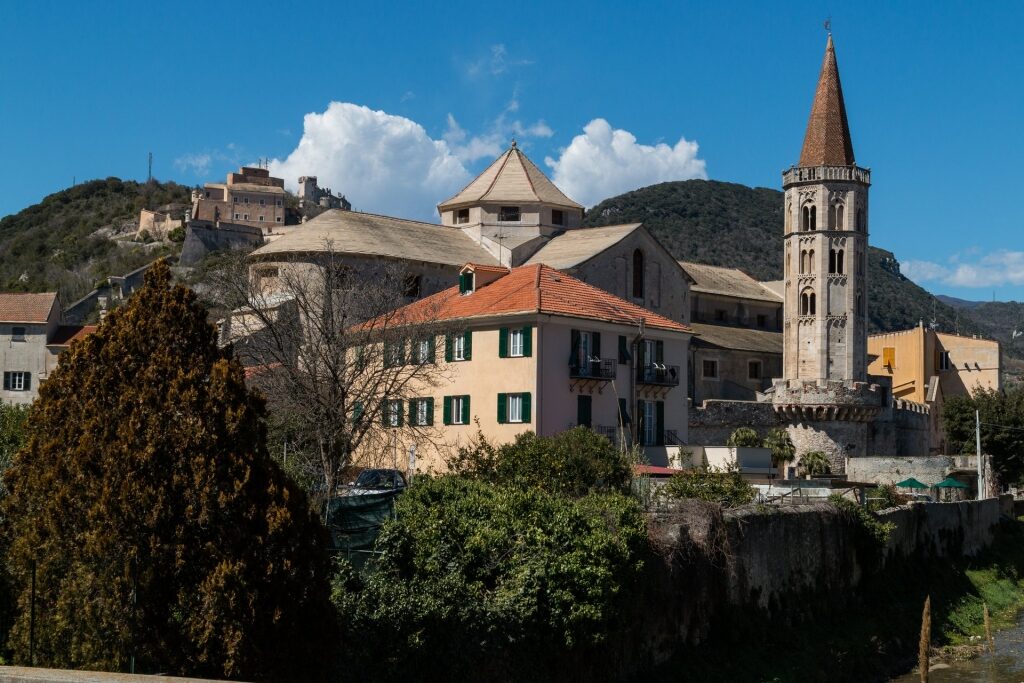
Finalborgo
If you manage to tear yourself away from the macaroons, the hills of scented scrub behind Alassio are peppered with wonderful destinations. Half an hour’s drive brings you to the medieval walls of Finalborgo, its exquisite and intact historical center a maze of artisan shops. Even closer is Verezzi, an agglomeration of four hamlets constructed from a particularly attractive rose-colored stone.
The Verezzi hamlets were apparently established by pirates who sought a wide-ranging prospect over the bay. The pirates, it seems, did their homework. The views are spectacular, especially from Piazza Sant Agostina, and Verezzi has grown into a honeycomb of bars, boutiques, and restaurants without a pirate in sight.
Genoa
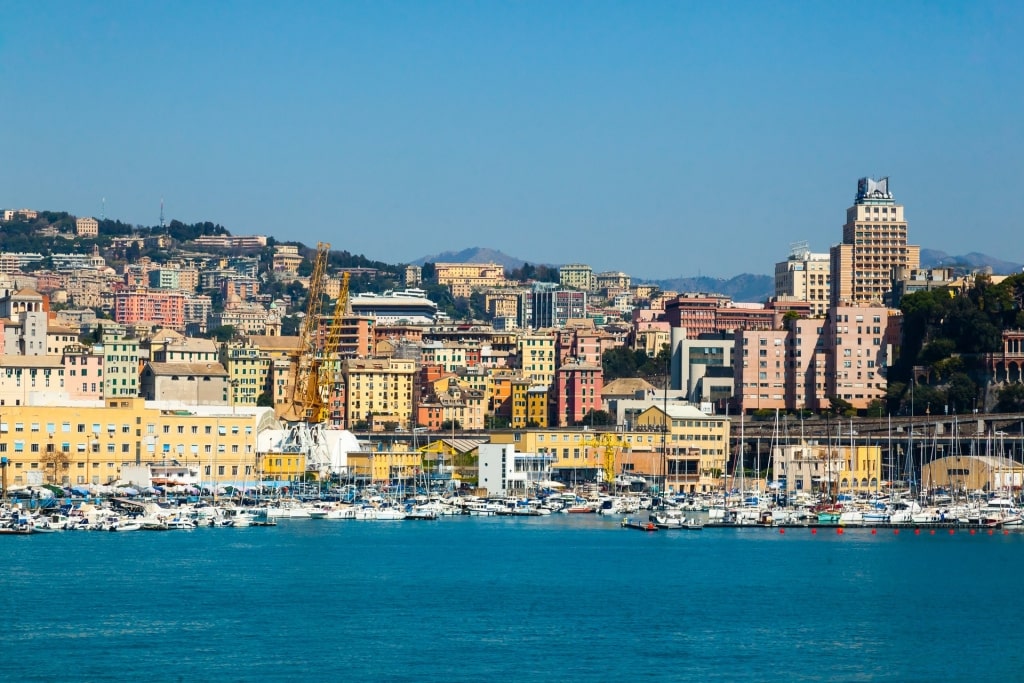
Genoa
One of the Italian Riviera cities with the most history, Genoa is a must to explore when you’re on the Ligurian coast. Of course, the home of pesto has a busy commercial port and draws an unfavorable contrast to the candy-striped Italian Riviera towns. Give it time, however, and Genoa will reveal its abundant treasures to you.
The capital of the Italian Riviera is famous for its UNESCO-listed medieval center, the largest intact example of its kind in Europe. This neighborhood is a web of flagstoned alleyways that open up into compact piazzas blooming with café tables.
Inserted amid the historic chocolate shops and window displays of fresh-baked focaccia are the grand merchant houses that stand as a testament to the medieval Republic of Genoa’s immense wealth.
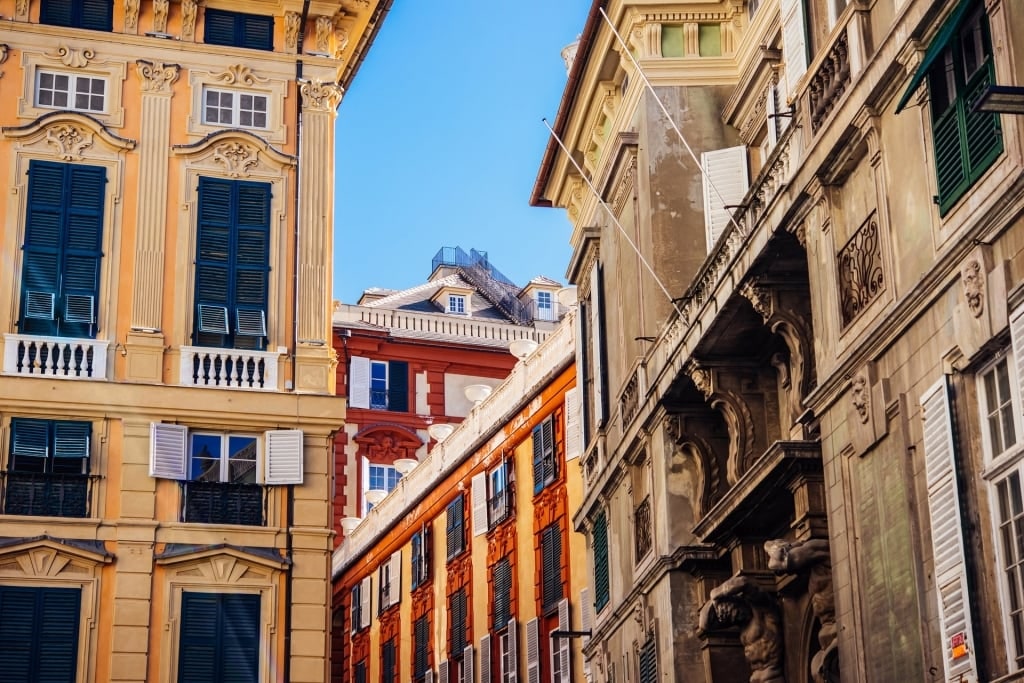
Genoa
While several are open year-round as museums, if you time your visit wisely you’ll be able to do a grand tour of over 150 of these Renaissance edifices. The most ostentatious of the merchants’ palaces are found in the medieval center and fronting onto the UNESCO-listed street of Via Garibaldi.
Once you’ve drunk your fill of grottos, frescoes, and gilt corridors, it’s time to get back to the sunshine. Make your way to the seafront fishing village of Boccadasse, now a Genoese neighborhood, for reentry into the pastels and pebble beaches of Genoa.
Read: 12 Best Beaches in Italy
San Remo
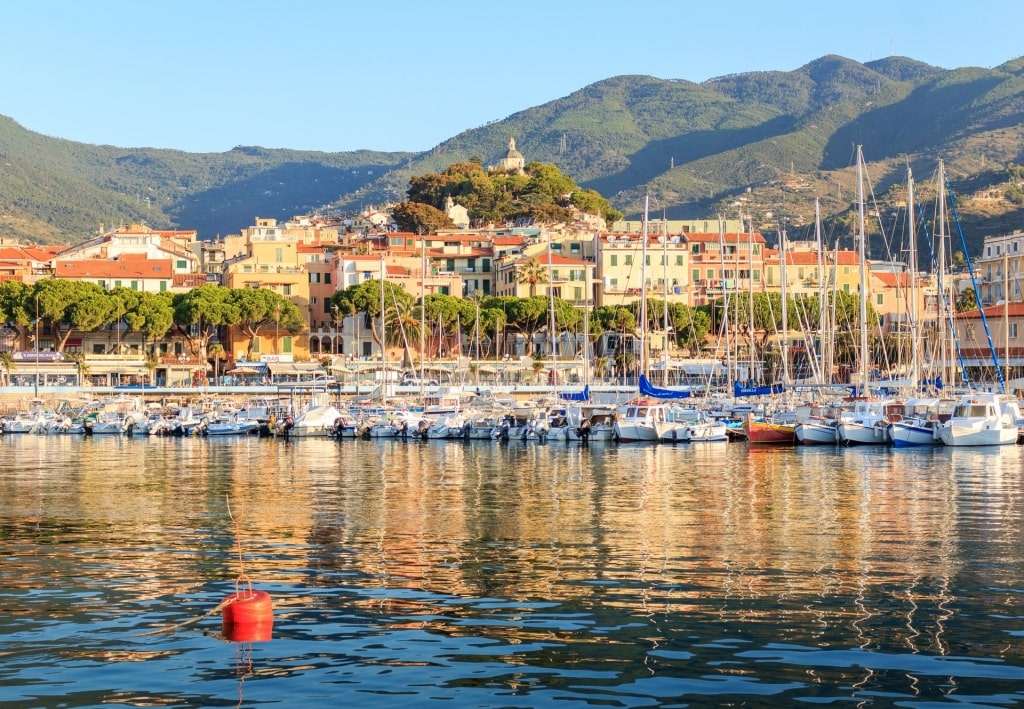
San Remo
Of all the Italian Riviera cities, it is San Remo that really brings the classic charm in spades.
Discovered by tourists around 1860, the interest prompted the construction of a railway, since transformed into a popular cycle trail. With the railway in place, San Remo’s golden age had dawned. However, while the English and Germans were particularly keen on this stretch of the Riviera for a little winter sun, it’s the Russians who can claim the real special relationship.
Arriving in 1874, the vacationing Empress of Russia felt so invigorated by the visit that she donated the palm trees that line the peach marble promenade, named “Empress Walk” in her honor. The most visible symbol of San Remo’s old-style glamour has to be its art nouveau casino, Italy’s oldest, with the proportions and placement of a town hall.
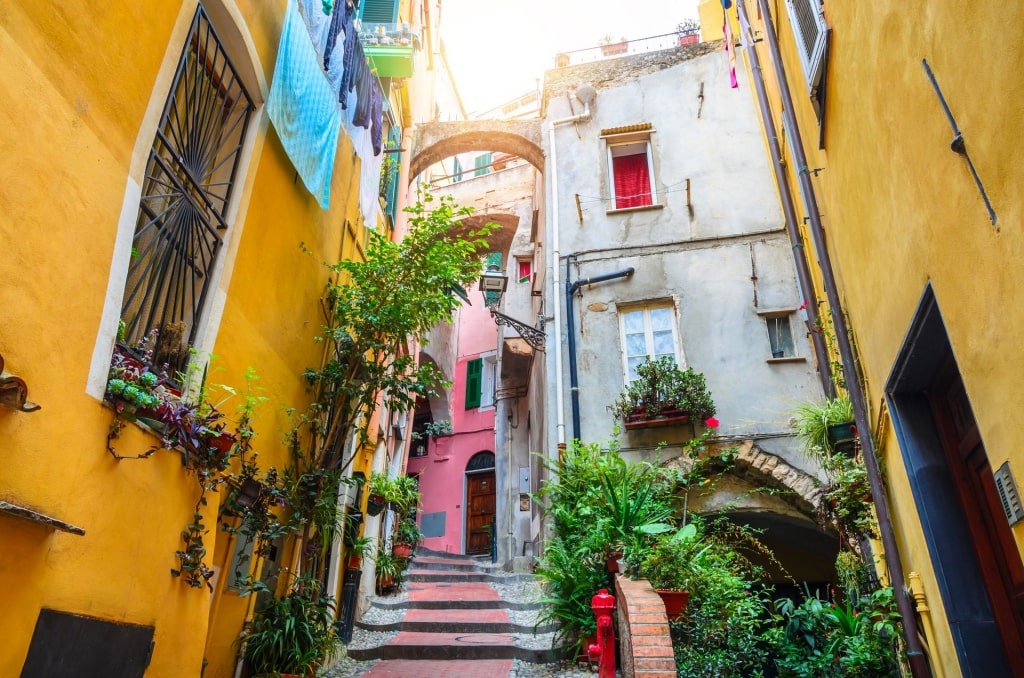
San Remo
Empresses and roulette wheels aside, San Remo holds even more ancient treasures near to its heart. Walking past the tumbling bougainvillea, accordion buskers (this is Italy, after all), and elegant, 19th-century seafront hotels, you’ll arrive at San Remo’s Old Town.
Known as “the pine cone” for the way its spindly, 15th-century streets appear on a map, the Old Town immediately transports you away from the hubbub and high living into the worn stone and serene timelessness of a traditional Italian village.
Rapallo
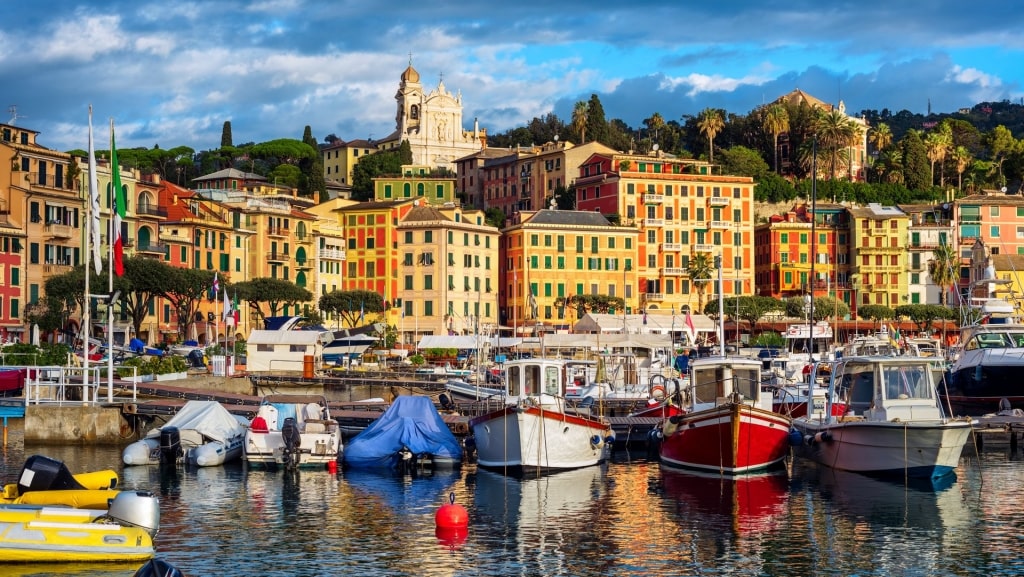
Rapallo
Widely regarded as a good base for exploring Portofino and its surroundings, Rapallo itself is also well worth your time. Indeed, a fantasy dinner party’s worth of literary luminaries certainly thought so, including Nietsche, W.B. Yeats, and Ernest Hemingway, who based a short story on a visit to the town.
Backed by wooded hills dotted with villas, and a scenic golf course, Rapallo is a colorful place with a palm-fringed promenade, spacious beaches, and a rather dumpy 16th-century Italian castle.
The charming fortification, a symbol of the town, projects out into the sea looking a little like a militaristic Noah’s ark that’s run aground. You’ll also come across a public Italian garden dedicated to the modernist poet, Ezra Pound, another admirer of the town.
At some point on his visits to Rapallo, Hemingway checked into the luxury Excelsior Palace Hotel. A swordfish steak in the restaurant here while gazing out over the panoramic views of speedboats and the hills of Portofino is well worth your time. With the wash of waves against the rocks below, even the gulls here sound more refined.
Portofino
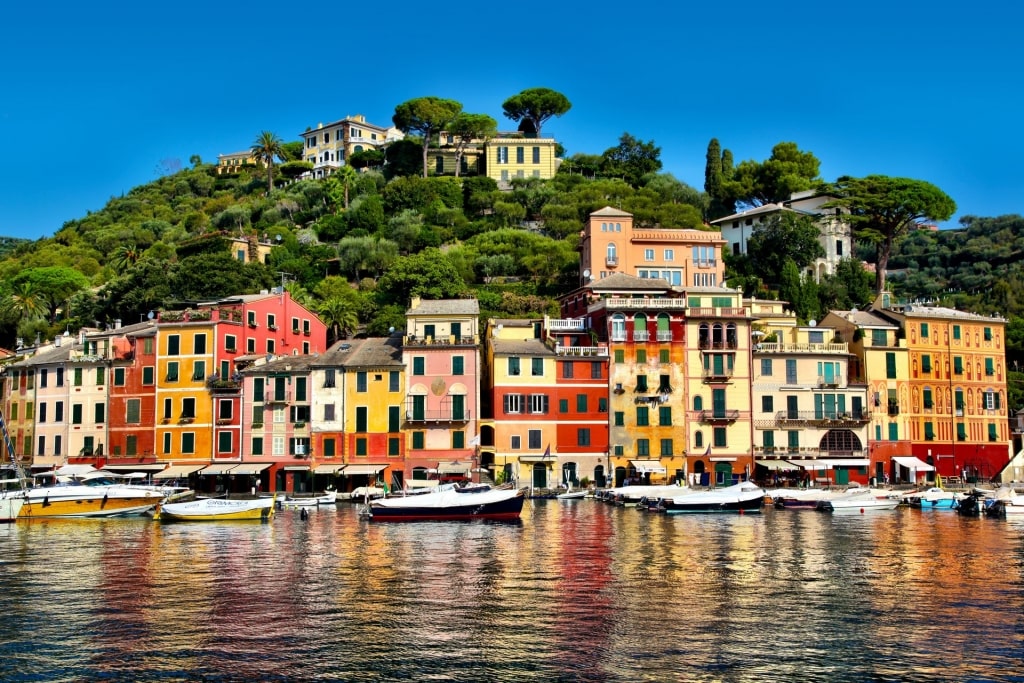
Portofino
The masterpiece of the Italian Riviera towns, Portofino is a vision of pastels shimmering above an emerald harbor. It’s tiny, especially with a superyacht or two moored nearby for contrast.
The coast chosen for this place is as inspiring as the village: maritime pines, like natural sun umbrellas, divide the sunlight across the rugged, verdant cliffs daubed in colorful patches of scrub. Painted across this lush hillside, Portofino’s pastel homes in shades of ochre, lemon, and terracotta overlook a gorgeous little harbor strung with fluttering naval flags.
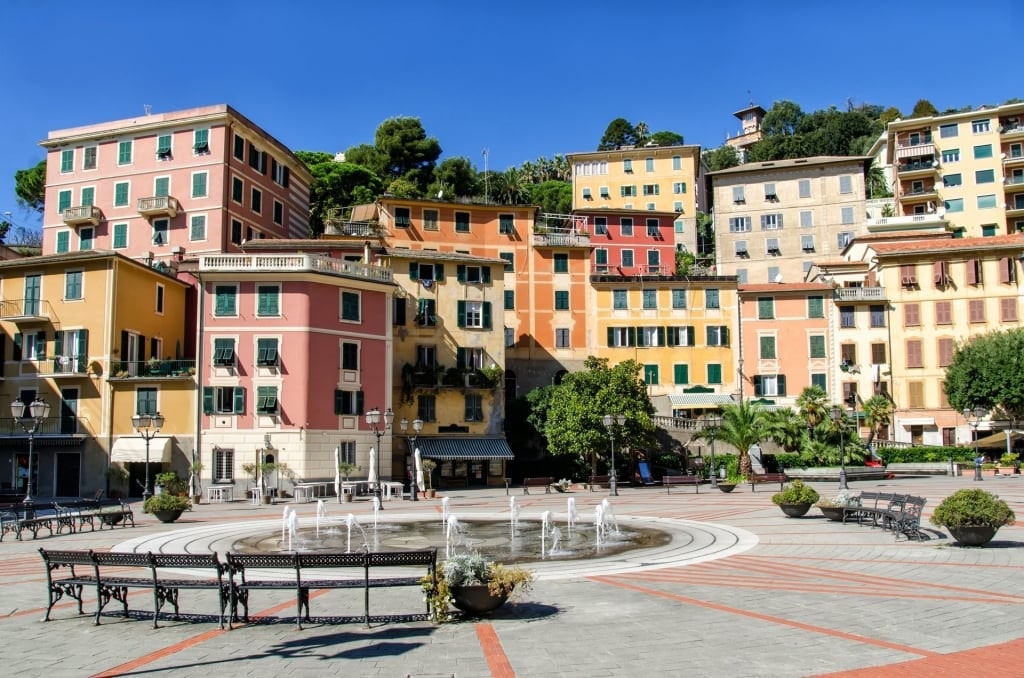
Portofino
Over the years, the town’s irresistible charisma has drawn Prime Ministers and poets including Winston Churchill and Guy de Maupassant. Today, the cobbles on the restaurant-lined square have an impressive shine from the tourist traffic, but the ban on motor vehicles means that it never feels choked like some other semi-mythical Italian towns.
One of the best things to do in Portofino is to follow the lane up to the church for the perfect photographic perspective over this seminal Riviera town. Linger into the evening, and you’ll watch as the fireflies emerge from between the pines and black fish dart beneath the deepening blue of the sea.
Manarola
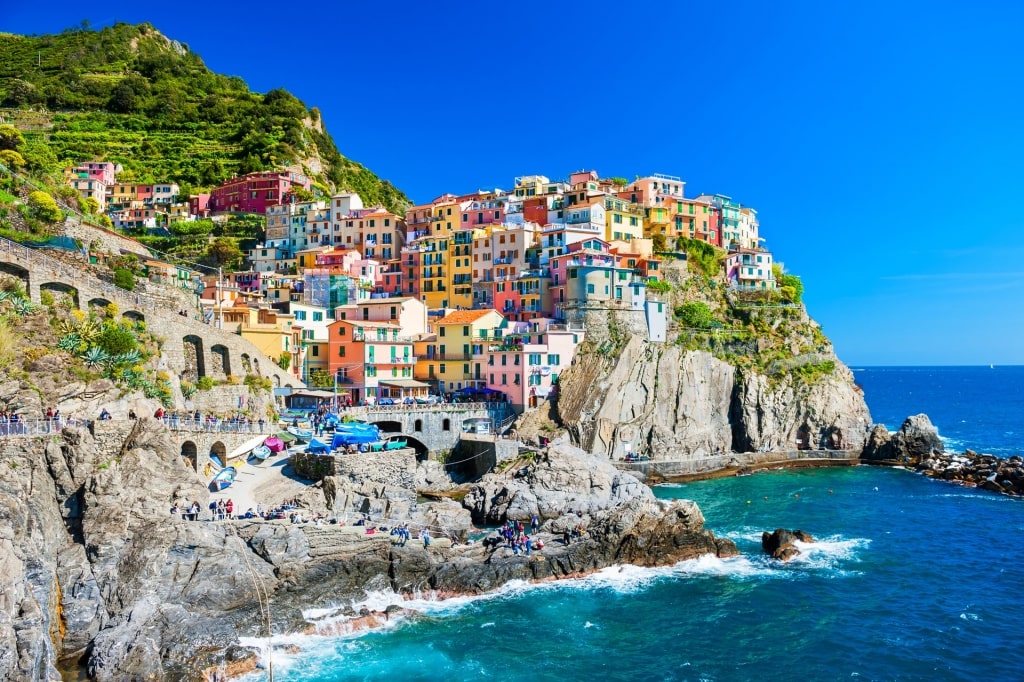
Manarola
The Cinque Terre only became a superstar destination after 1874, when the railway connecting this isolated community of fishing villages with the world was completed.
Trying to choose between these Italian Riviera towns and villages is a little like the Judgement of Paris; each has its own unique charms. Of all of them, the oldest, Manarola, is often described as the most romantic, the one that would have inspired Byron to leap off its black cliffs into the azure sea below.
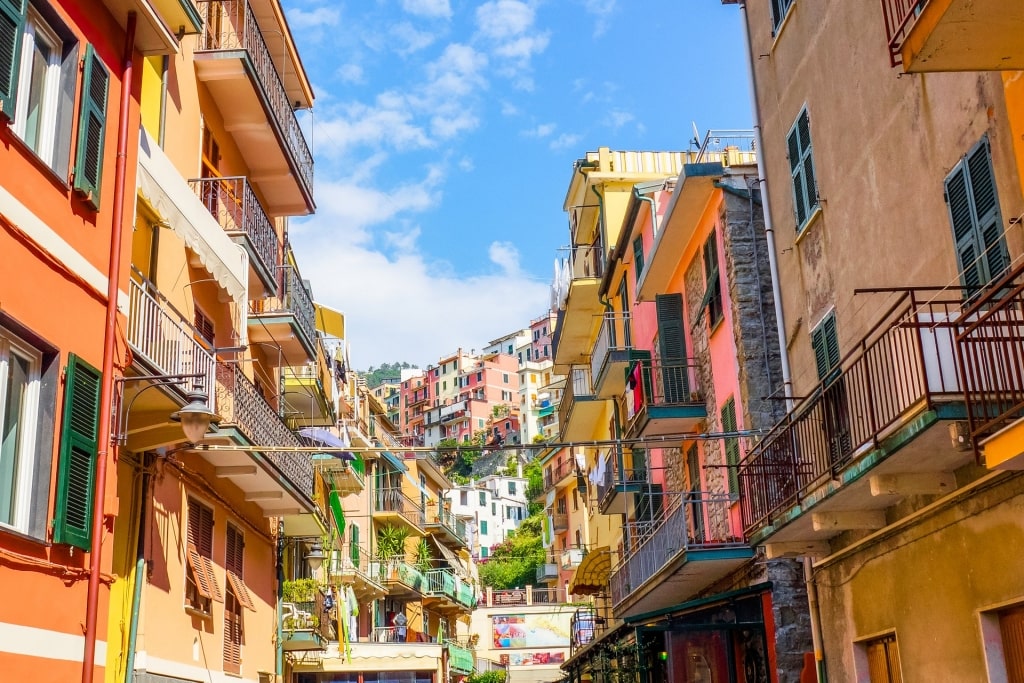
Manarola
Above this natural limestone step, elevated from the sturm und drang of the winter sea, the houses, church, and belltower cozy together across the diminutive hilltop. Manarola is the second smallest of the Cinque Terre, its narrow alleyways filled with the bite of salt air, garlic seeping from its kitchens, and jasmine climbing the colorful house fronts.
For one of the most romantic tables in the Cinque Terre, and by extension, the world, find the white umbrellas of Nessun Dorma, just beneath the Punta Bonfiglio panoramic viewpoint. A bottle of the local white wine and a sharing platter of salumi, Ligurian cheeses, and bruschetta at one of their tables while the sun deepens the colors of the old facades is a classic Riviera moment.
Read: Best Things to Do in Cinque Terre
Experience all of these beautiful Italian Riviera cities and towns on a cruise to Italy. Browse our cruise itineraries online and book an Italian vacation worthy of an epic poem.
